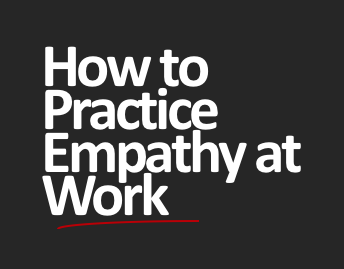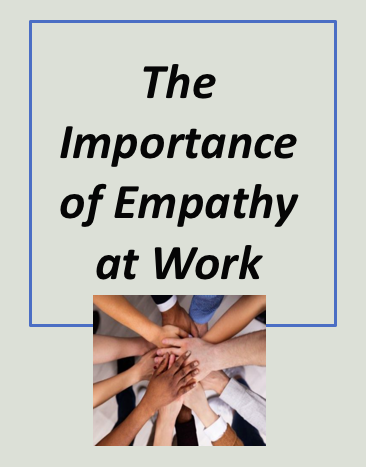Being A Great Leader Today Takes Hard Work
/Being a great leader takes hard work, determination, and dedication; it’s a big responsibility. To explore with you what makes a great leader today, I’d like to talk about the elephant in the room so we can all be on the same page. Being a great leader today is a very different job than it used to be. And, while you and most of the people around you may be just beginning or in the middle of your career, I encourage you to recognize many of the management ‘structures’ most of us work within, as well as the mentors we have had at home, school and work have been strongly influenced by ‘old-school’, hierarchical leadership style. It is still a relatively new experience to be a leader of many as four different generations in our workplaces and to have to navigate the needs, challenges and opportunities that today’s highly technical and international work cultures offer. Again, it is a big responsibility.
So what does being a great leader today mean? Well, it has very little to do with being a boss and a great deal about inspiring everyone you work with. It means creating a team out of a group of individuals while respecting and encouraging their individuality. Being a great leader also impacts every email, every conversation, every meeting, every goal strategy session, every difficult conversation, and every performance review; it means we are always ‘on’.
One more thing before we get going because I hear “But I’m an introvert” frequently. Well, I can honestly share I am also an introvert, and I know it is possible to help everyone around you to believe in themselves and what they can accomplish in ways that are comfortable to you so that you can still feel authentic and respect your individuality. But let me also reassure those of you who are extraverts. No matter if you are an introvert or an extravert, both tap into empathy on a regular basis, therefore we can be genuinely empathetic when we are working to inspire people around us. It’s just that each tap into it in different ways.
If you are still asking the question, “How do I unlock my leadership skills so I can take myself and my team to the next level?” Great! That’s what I like to hear. Let’s explore how you can unlock your full potential which requires through a bit of self-reflection / self-awareness and how you can invest in yourself.
Self-Reflection / Self-Awareness
A high degree of self-reflection / self-awareness is foundational to being a great leader. It is empowering to know how you act when faced with feelings like curiosity, surprise, difficulty, or joy. It is also empowering to know how others “see” you. Are you approachable, warm, trustworthy, curious, and fair or are you the opposite? Do you have a reputation as being dependable and creative or are you known as the first one to look for an opportunity to delay a project or deflect responsibility? In a nutshell (as my dad would say), what are your best characteristics… and which ones might be holding you back, and frankly also holding your team back?
Being self-aware is one of the most important of all the soft skills we will discuss because it provides an opportunity to explore many of the other leadership characteristics of great leaders. It is a process where you can learn about yourself and help you set new expectations for your own personal and professional development. I also want to acknowledge that exploring your own self-awareness takes a bit of courage… ok, perhaps a lot of courage. The journey may make us feel exposed and vulnerable… especially if we believe a leader must exhibit unshakable confidence and authority.
I recommend taking a three-pronged approach in your self-reflection / self-aware journey.
Know you are likely going to hear things that will be a surprise. This surprise may be positive, but may also be… constructive. With challenging news, don’t get defensive, and don’t blame those people who cared enough for you that they chose to trust you and share their observations and experiences. Instead, be grateful and accept the information humbly and with a growth mindset – accept you are going to use that information productively to better yourself.
Approach trusted friends, family and colleagues. We cannot rely on only our own interpretation of our impact. If we do we may not see or learn about behaviours that are challenging. And to be fair, we may not see or undervalue some of our most important qualities.
Let your trusted community know you are looking to improve yourself and need their help. If you think they will be hesitant to share this feedback with you in-person, that may already be a red-flag for you. But, if you want to make an accommodation for them, arrange it so that everyone submits their responses to questions anonymously, in writing. Ask questions like:
a) Do I inspire confidence within the people I work with?
b) When challenges arise, how do I deal with them? Do I inspire calm?
c) Do I stay grounded when I feel overwhelmed?
d) Do others feel I help them feel proud of their work? How frequently do I do this?
e) Do I appear to share information (transparency) or be somewhat guarded?
f) Am I a good listener?
g) Do I encourage others to share their point of view, thoughts, experience?
h) Do I empower others to be able to work independently?
i) Do the people around me feel I trust their work and their experience?
j) What are my best qualities? What should I keep doing?
k) What qualities should I work on? How can I improve?
Use a formal 360 type feedback mechanism which is very popular in at-work environments. 360’s are an anonymous feedback process where (as an example) co-workers, people who report into us, colleagues from other teams and potentially even clients and suppliers are asked to provide their written feedback to predefined questions.
Your search should gather information about your success in creating an inspired culture of trust, cooperation, and respect. Are the people you lead guided by shared goals and values and proud of what they accomplish as well as what the team accomplishes?
In the end, recognize there is great power in this exploration since nobody rises to low or no expectations.
Exercise Your Comfort Communicating
Being a great communicator is another of the most important leadership skills. Being crystal clear about the information you share with others as well as how you are sharing that information gives the people around you a rich understanding of what is expected of them. Crystal clear communication is critical to helping those around you feel included, that everyone has the information they need to feel empowered and successfully get their jobs done.
Great communication provides team members a shared focus of their work and greater alignment of the decisions they make whether they are working late at night by themselves or in the middle of a team brainstorming meeting. Being a strong communicator is also an opportunity to reinforce your shared company vision and values; the ‘Why’s and How’s’ associated to their work. Exercising your comfort communicating also means being generous with encouragement and praise.
Simply put, clear understanding, autonomy and responsibility encourage pride in their effort, self-esteem, confidence, and builds leadership skills in others. With more and more of the people working remotely some or all the time, our comfort communicating is now even more important.
Offer Encouragement And Praise When It Is Due
Being a great leader means taking opportunities to make sure people know they are doing well. Once a year during a 10-minute performance review just doesn’t cut it anymore. We all have a need to feel a sense of relevance and progress. You and I want to feel the work we do is meaningful and we are adding to the greater good. The greater good could be the team, it could be the company, it could be our community and planet… or it could be all of these.
Encouragement and praise from other people – especially people we trust and admire is like using a high-performance gasoline. Still the same engine, but now we are empowered to do more… and we do this with an exciting vroom vroom in our step.
And don’t worry, especially if outward praise doesn’t come natural to you. Encouragement and praise don’t have to be complicated (or expensive). Employees don’t need front-of-the room presentations, and they don’t need expensive bonuses (although nobody I know would say no to a cash bonus). Unfortunately, using money as the primary symbol of praise and recognition is a legacy of my dad’s generation. Don’t get me wrong – being paid fairly is important, but verbal and even non-verbal feedback is amazingly powerful… and timely. For example, when you see Bruce doing a great job solving a client issue, tell him… and be specific about what he did well. Say something like, “I saw how you took initiative and worked to fully understand what they needed and then offered a few solutions so they felt they had choice.” Or “Bruce, I noticed how you re-formatted all the tables in the presentation to follow the same layout. Even though content was from three departments, it reinforced how we are trying to project a single source solution.”
Stay In Touch
Staying in touch is more than going to meetings, assigning projects, and giving or getting updates. Sure, all those things are important and must be done but staying in touch with your team also means listening and being there for them.
The thing is, staying in touch is a two-way-street. It is an opportunity to get ahead of challenges – sure – but it should be so much more. Staying in touch is an opportunity to build a micro-culture where you enjoy trusting relationships with others, where you learn what motivates people, you get to know them… and you give them an opportunity to get to know you.
I want to encourage you to consider other opportunities to build trust and community by staying in touch. Create a routine where you regularly check in with your employees. Don’t leave these discussions and relationship building opportunities to their annual or semi-annual performance review. For example, have formal monthly meetings with your senior team. In addition, set and prioritize bi-weekly one-on-one meetings with each member of your team (or even a business partner) with the goal of being there for them verses them being there for you. For example, have what I call ‘15-minute Laser Meetings’ where your team member is the one who decides the agenda. They come to the meeting prepared to discuss one or two topics that are important to them and might include:
Project updates (if that is their choice)
An FYI on potential risks that may be brewing with a project or supplier
An outright ask for your help to get buy-in from another department (or person)
A discussion on how they are feeling overwhelmed by their workload
An update on some family challenges that may require some workplace flexibility over the next month
A request for career advice or to help them find a mentor
A request for professional development training
One amazingly powerful way to build a trusting workplace community and stay in touch is to go macro during some of your one-on-one (and team) meetings. Instead of discussing the detail of a project, discuss the impact of their work and a project on the overall organizational goals and values.
Another way to stay in touch is to recognize success. When is the last time you ended a meeting or video call and simply (and genuinely) said something like, “Hi Paula, I noticed how confident and well prepared you were for the briefing yesterday. You did a great job. I hope you are proud of yourself.” Imagine how inspired Paula will be for the next week… and potentially even longer.
When you are experiencing organizational change, I can assure you that this is a time when staying in touch is imperative. When facing such challenges as navigating organizational change, be transparent about the tasks at hand and infuse your team with a shared vision of how your company can benefit from the impending transition. Continually provide updates and reiterate the plan for moving forward to ensure your employees are aligned and understand how their work factors into larger corporate objectives.
Being self-aware helps you stay in touch. For example, if you are an extravert, being self-aware will help you pull back from what may be a natural tendency to insert yourself into the conversation, or to stop using sentences that start with, “What I would do would be to…”. Being self-aware may also help introverts give themselves a small push to engage in a different way. If all of this sounds like I’m encouraging you to exercise your soft skills, you are right.
Be Your Authentic Self… And Stretch Your Authentic Self
Can you imagine how many times have I heard someone say, “That is great for you, but that is not me” during a leadership-based conversation. If that is the case for you, here is some tough love. Being authentic doesn’t mean not learning and growing. You were ‘authentic’ when you started your first job. You were still ‘authentic’ last month, and since then I’m sure you have had new experiences that have further developed your authentic self. I’m not encouraging you to be someone you are not, I am encouraging you to be more aware of what is around you, and the opportunities you take to learn, grow and show your authentic self. I’d also encourage you to be curious about how people are responding to you and to situations you are involved in. After a team meeting or your monthly management meeting, do your team members hurriedly and quietly gather their belongings and rush out of your office, or are they usually energized and excited by your meetings?
Self-reflection is one way for you to choose to make a few changes in how you engage with others and from your investment, to experience some of the most immediate benefits, quickly inspiring trust, enhancing your performance, your team’s performance, and everyone’s pride and satisfaction from your shared accomplishments. So, I’m inviting you to decide how you might want to interact differently… for your own benefit and the benefit of those around you.
Find a balance where you can be yourself and still intentionally open yourself to new experiences and new things to learn. If you are an extravert, perhaps work on practicing your patience and listening skills. If you are an introvert, perhaps work on being ‘out there’ a bit more. As an introverted leader, having the structured laser meetings I discussed in the ‘Stay In Touch’ section might be a really good way to feel safe as you push yourself out of your comfort zone.
Being your authentic self through this journey will enable you to build a greater sense of trust… one of the most critical qualities of a great leader. When you are trusted and your team trust each other, each will proudly feel:
Less stress
Higher productivity
Greater engagement
Greater loyalty
Conclusion
We’ve discussed a lot of opportunity for you to become a great leader. As I was saying to someone just the other day, if you have time to address urgent issues, you have time to be proactive and take care of yourself and your team.
And let me share one last piece of advice. Have fun. Give yourself time to learn and adapt as you dedicate time for self-reflection and regular check-ins with your team. Allow yourself to make mistakes, because if you embark on this journey, you will make mistakes. Just apologize when you do – after all, you are only human.
Be well and happy communicating, leading and creating a culture of belonging.
Bruce
Learn More About Bruce Mayhew
Toronto corporate trainer and executive coach Bruce Mayhew Consulting is in the people business… it just so happens that training and/or executive coaching is involved. Let us help you improve your productivity and employee engagement.
To learn more about how leadership training can to improve your skills call us at 416.617.0462.
Bruce Mayhew Consulting's most popular programs are Email Etiquette Training, Difficult Conversations, Generational Differences, Leadership Skills Training and Time Management Training
Related Workshops That Drive Business Success
Toronto based corporate trainer and executive coach Bruce Mayhew Consulting offers leadership training and professional development across Canada and the USA.






















